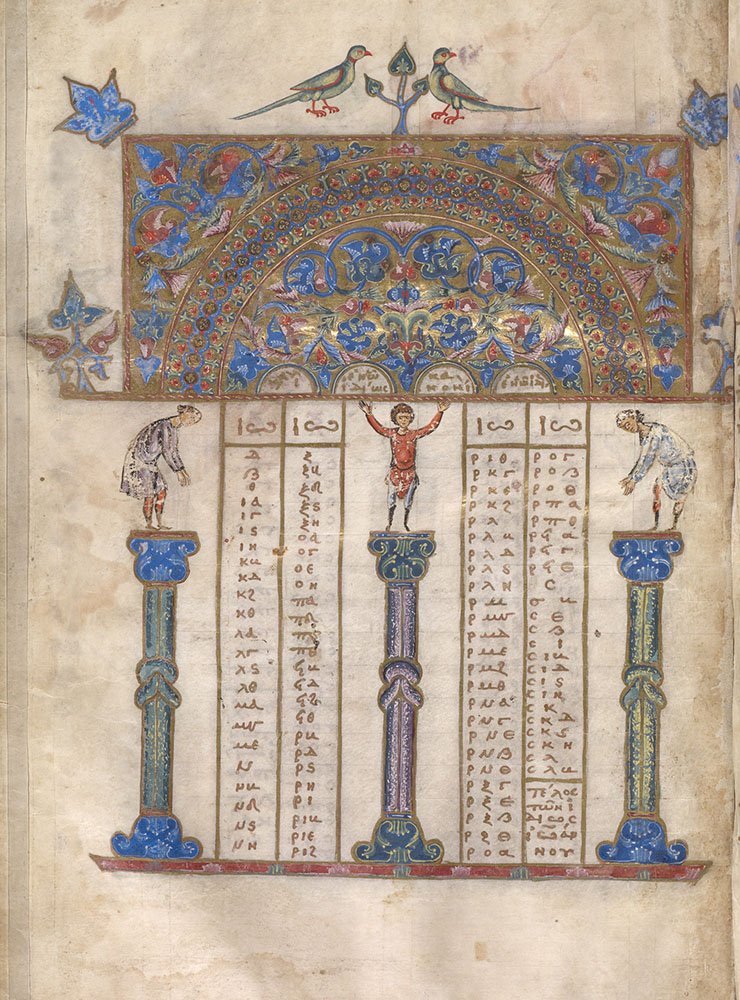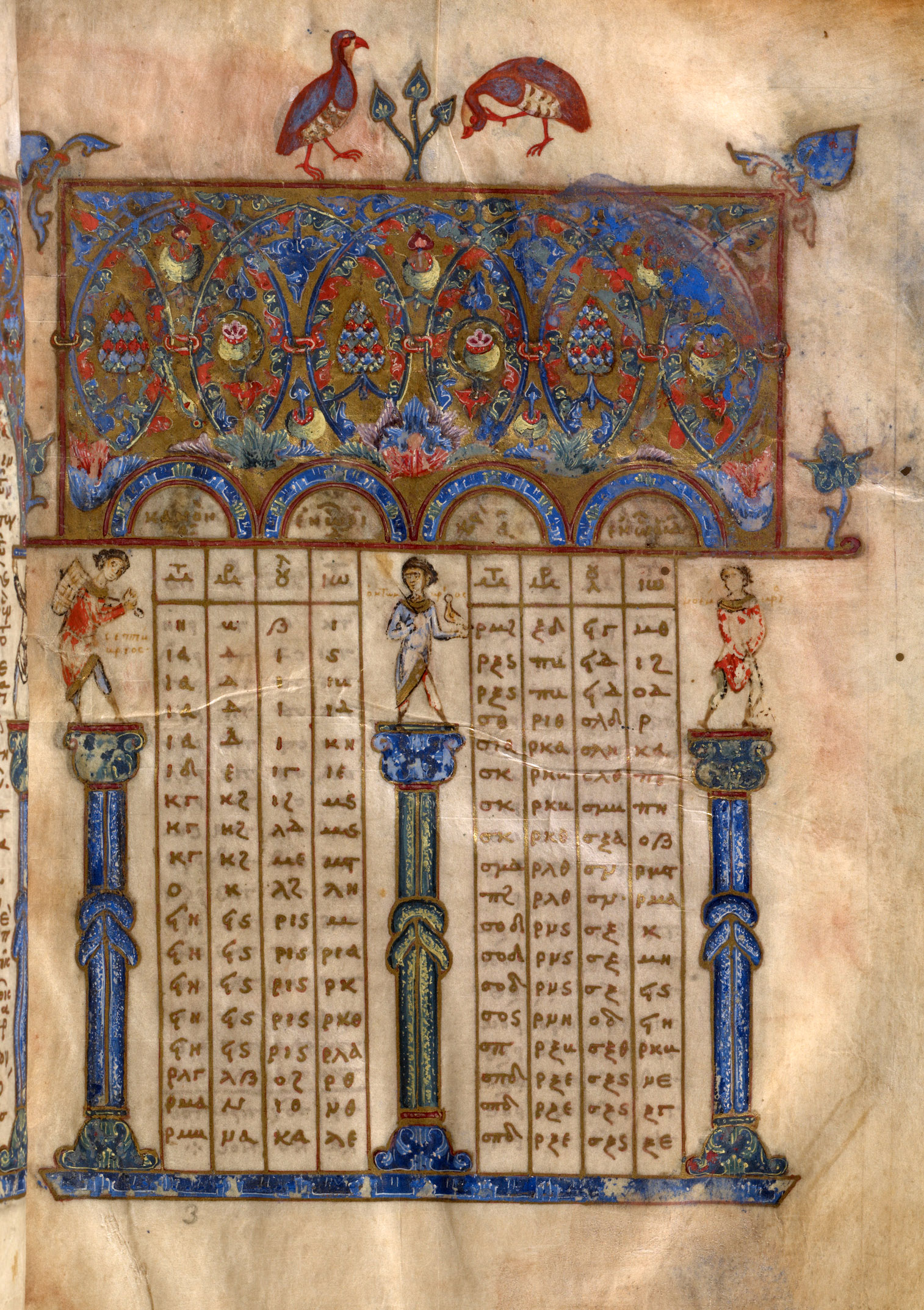 Gregory-Aland 662, an illuminated luxury minuscule - 9.5 in by 6.5 in - with 254 pages, is in National Gallery of Victoria in Melbourne, Australia since 1959. It is known as the Gospel Book of Theophanes and written in the first half of the 12th century in an Imperial Constantinopolitan scriptorium, probably located in the Great Palace near the five domed Nea Church, which was built by Basil I in the 9th century. It was dedicated by its scribe and illuminator with this dedication written in classic Greek iambic metre in gold letters:
Gregory-Aland 662, an illuminated luxury minuscule - 9.5 in by 6.5 in - with 254 pages, is in National Gallery of Victoria in Melbourne, Australia since 1959. It is known as the Gospel Book of Theophanes and written in the first half of the 12th century in an Imperial Constantinopolitan scriptorium, probably located in the Great Palace near the five domed Nea Church, which was built by Basil I in the 9th century. It was dedicated by its scribe and illuminator with this dedication written in classic Greek iambic metre in gold letters:
"Queen of all as Mother of God the Word
The donor as well as the scribe of the book and worker of the embellishments within it
Your monk and servant Theophanes"
The tall monk is dressed in a brown mantle over a black habit. He has a long black beard streaked with gray and a halo. In his hands is the manuscript set in a jeweled, silver-gilt cover. The marble kiot surrounding the two figures had a dome made of green porphyry from Laconia in Greece and a blue stone I can't identify with the same grain-pattern in it. It could be lapis or blue sodalite. The decoration of this page is very similar to the full-page church facade in another manuscript from the same scriptorium. There are several Cannon Tables which you can see on the left.
The Theotokos has been described as a Hodegetria - indicator of the way - but her pose is not the same as she is in the original icon, so the figure is just another generic illustration of the Virgin holding Christ. Her open hand - accepting his gospels - is extended towards Theophanes, it is little hard to see because the paint has abraided here. She also invites him to approach and worship her Son. The Virgin wears a violet maphorion with red fringe over a blue dress. Christ is dressed in gold. They stand on a golden dais set with gems and pearls. The text, written in brown and gold ink, is especially beautiful.
The men that are painted above the columns are interesting, They could be representatives of the circus factions that wore different colored uniforms and were involved in ceremonies in the Great Palace and the Hippodrome. They might be acrobats. Another can be seen carrying a bag over his shoulder, another is dropping gold coins which he takes from his cloak, one sits at a fire and another holds a bird. At the top of one of the Canon Tables you can see a pair of green parrots, which were popular pets in 12th century Constantinople. Theophanes was a very creative man!
There are some strange blue blotches of paint in the arch above Theophanes and the Theotokos. These colors detached from the blue arch on the opposite page and stuck here. There are quite a few places where this happened which you can see if you look for them.

The book was probably given by him to the monastery where he lived. Perhaps he kept and used the Gospels throughout his life, leaving it to the monastery at his death. He doesn't mention the name of his monastery, he assumes the readers of the gospel would know who he was and where it was housed. However, Gospels were a book of private use: monastic libraries owned few of them, though individual monks did own them, and the great donors who willed their libraries to monasteries seldom included Gospels in their donation. The four volumes of the New Testament are called a Tetraevangelion in Greek.
He must have been a well-off monk to have afforded the cost of the parchment and silver-gilt cover. Perhaps he was a former noble, merchant or courtier at the Komnenian court who became a monk with a legacy. Because he has a halo - something only seen on Byzantine royalty - means he must have been a former Komnenian prince - or else the halo was added after he died. On the other hand he could have simply been a successful monk-artist who received expensive commissions for his work. It is also odd that Theophanes is taller than the Theotokos.
There are other manuscripts created in the same workshop, among them the Codex Ebnerianus, a New Testament in the Bodleian Library and was also still in Constantinople in the 17th century. It was created for Manuel I's uncle, Isaac Komnenos, who was one of the founders of the Chora Church. Two other manuscripts, known as the Kokkinobaphos Homilies on the Life of Mary, were also produced there, one copy is now in Paris and the other is in the Vatican library. Finally, a copy of a Four Gospels created for John II Komnenos was created there with Imperial portraits of John and his co-emperor and son Alexios.
All of these manuscripts use a lot of brilliant, pure, ultramarine blue, which was ground from the finest quality of lapis lazuli from mines high up in the mountains of Afghanistan. This pigment was more expensive than gold and is extremely difficult to prepare as a pigment. It has to be ground to very fine texture and then combined with egg tempera in a complicated process. It is also worth noting that the Greek that was used in the New Testament of the time was the same language used by the Byzantines. Unlike the west with its requirement that the Bible we written in a dead language, Latin, there was no impediment to any literate person accessing and understanding it and the writings of the Fathers of the early church.
The manuscript includes all four Gospels and has a Eusebian Canon list at the beginning. The gospels are all missing their evangelist portrait pages. I have added a portrait page of Mark and another of Matthew on the right at the bottom of the page that were created in the same scriptorium. These pages were cut from a Gospel Book in the Great Lavra of Mt. Athos. Today they are in the Walters Art Gallery in Baltimore, having arrived in 1931.
The Theophanes manuscript has been in the possession of several hands in modern times. It was sold at a Sotheby’s auction in the late 19th century, and came into the possession of the National Gallery in the early 20th century. It is currently not on exhibit. It seems the entire manuscript has not been scanned. This is probably the reason it is not well known.

















 click here for icons of christ
click here for icons of christ click here for icons of the theotokos
click here for icons of the theotokos click here for icons of angels
click here for icons of angels click here for icons of saints
click here for icons of saints








